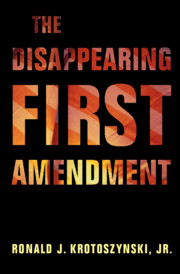Book contents
- The Disappearing First Amendment
- The Disappearing First Amendment
- Copyright page
- Dedication
- Contents
- Preface
- Acknowledgments
- Table of Cases
- 1 Two Steps Forward, One Step Back
- 2 The Public Forum Doctrine and Reduced Access to Government Property for Speech Activity
- 3 The First Amendment As a Source of Positive Rights
- 4 Whistleblowing Speech and Democratic Accountability
- 5 Shedding Their Constitutional Rights at the Schoolhouse Gate
- 6 Transborder Speech
- 7 Systemic Failures to Protect Newsgathering Activities by Professional Journalists and Amateur Citizen-Journalists Alike
- 8 The Citizen As Government Sock Puppet and the State Masquerading As a Citizen
- 9 Using Constitutionally Permissible Statutes to Impede First Amendment Activity
- 10 Conclusion
- Notes
- Index
2 - The Public Forum Doctrine and Reduced Access to Government Property for Speech Activity
Published online by Cambridge University Press: 02 August 2019
- The Disappearing First Amendment
- The Disappearing First Amendment
- Copyright page
- Dedication
- Contents
- Preface
- Acknowledgments
- Table of Cases
- 1 Two Steps Forward, One Step Back
- 2 The Public Forum Doctrine and Reduced Access to Government Property for Speech Activity
- 3 The First Amendment As a Source of Positive Rights
- 4 Whistleblowing Speech and Democratic Accountability
- 5 Shedding Their Constitutional Rights at the Schoolhouse Gate
- 6 Transborder Speech
- 7 Systemic Failures to Protect Newsgathering Activities by Professional Journalists and Amateur Citizen-Journalists Alike
- 8 The Citizen As Government Sock Puppet and the State Masquerading As a Citizen
- 9 Using Constitutionally Permissible Statutes to Impede First Amendment Activity
- 10 Conclusion
- Notes
- Index
Summary
Over time, the federal courts have become predictably and consistently less willing to force government – at all levels – to make public property available for First Amendment activities.1 For would-be speakers who do not own property suitable for holding a mass protest or rally – or even for a peaceful picket or leafletting exercise – access to government-owned property is simply essential to their ability to speak.
Moreover, this holds true even in the age of the internet. As I will explain in greater detail, public protests, featuring face-to-face, real time interactions, remain essential to the process of democratic deliberation because real time, in person encounters permit the effective targeting of a particular audience and also because the mass media’s coverage of public protests opens up a wider dialogue within the body politic as a whole. A Facebook post or Twitter “tweet” lacks these important characteristics. In addition, social media platforms are privately owned and, accordingly, need not permit speech that they would prefer to censor or suppress. The usual suspects offered as the new (virtual) town square are not cabined by constitutional proscriptions against viewpoint or content discrimination. Simply put, some speakers and some speech are not welcome on Facebook, Twitter, YouTube, and Instagram.
- Type
- Chapter
- Information
- The Disappearing First Amendment , pp. 22 - 46Publisher: Cambridge University PressPrint publication year: 2019



